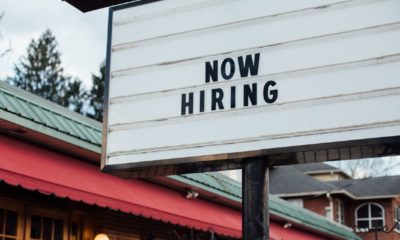Economy
Home Builders Face Labor Shortage Woes
The lack of workers with the necessary skills is hurting the construction industry.

In the last quarter of 2015, the findings of a survey by the Associated General Contractors of America already gave a preview of the labor shortage woes that home builders are currently facing. The survey revealed that nearly 80 percent of construction businesses were having a difficult time finding qualified skilled labor.
In fact, in “The construction labor shortage: Where did all the skilled labor go?” — an article published on the Tradesmen International website — it was pointed out that the current labor shortage actually began when the home construction industry bottomed out in 2011.
Long-Term Dilemma
“The shortage of skilled craft workers in the U.S.” — a research paper presented by the Construction Industry Institute (CII) — confirmed that labor shortage woes have persisted. The CII conceded, “Shortages of skilled craft workers continue to plague the construction industry. Employers have attempted to identify the root causes and to develop strategies to overcome these shortages. Despite this research and the efforts to stem the problem, the construction industry’s skilled worker pool continues to shrink.”
In a feature in The Wall Street Journal, Kris Hudson and Jeffrey Sparshott reported, “The delays, economists and builders said, could dent builders’ profits in the short term due to higher labor costs and concessions to buyers.”
They went on to cite the September 2015 survey of 74 builders by industry tracker John Burns Real Estate Consulting Inc.. which reported slowdowns as long as two months. Yes, home builders have had to wait that long for carpenters, drywall workers, foundation pourers, and housing construction specialists.
In November 2015, data from the Bureau of Labor Statistics and National Association of Home Builders (NAHB) revealed that there were 143,000 vacant construction positions all over the country.
The National Association of Home Builders (NAHB) is a trade association based in Washington, D.C. that aims to “enhance the climate for housing and the building industry.” It has more than 800 state and local associations under its fold and over 140,000 members.
At that time, the NAHB likewise revealed that 69 percent of its members “were experiencing delays in completing projects on time due to a shortage of qualified workers, while other jobs were lost altogether.”
Roots of the Problem
Industry experts have identified several factors that have consistently contributed to the labor shortage. They are the following:
1. The skilled workers may have quit the industry or relocated. The Bonded Builders Warranty Group cites a recurring trend: “A likely reason for the shortages and unfilled openings is that, during the downturn, many workers left the industry, developed new skills, and are not coming back. Other workers may have simply moved away and are not now living in the places where demand for new housing is recovering at the fastest pace.” Moreover, NAHB chief economist David Crowe also revealed in a November 2015 Builder feature: “The Census Bureau recently published a report utilizing detailed employment records over the past 15 years. About 60 percent of former construction workers either went to some other industry or remain unemployed. Only 40 percent returned to construction after the bust.”
2. There's no new blood. Most high schools have stopped holding shop classes. More and more high school graduates have also opted to pursue four-year college degrees. They eventually seek white-collar jobs. As the CII observed: “The journeyman-level work force is as educated as the rest of the U.S. population.” The group likewise added that “the construction work force is failing to attract women and minorities.”
3. They wages are not attractive. “Construction pay scales have not kept their relatively high position over the bust and start of the recovery,” Crowe noted. This, of course, puts off skilled workers just as it would put off other workers in different industries.
[ms_divider style=”normal” align=”left” width=”100%” margin_top=”30″ margin_bottom=”30″ border_size=”5″ border_color=”#f2f2f2″ icon=”” class=”” id=””][/ms_divider]
[ms_featurebox style=”4″ title_font_size=”18″ title_color=”#2b2b2b” icon_circle=”no” icon_size=”46″ title=”Recommended Link” icon=”” alignment=”left” icon_animation_type=”” icon_color=”” icon_background_color=”” icon_border_color=”” icon_border_width=”0″ flip_icon=”none” spinning_icon=”no” icon_image=”” icon_image_width=”0″ icon_image_height=”” link_url=”https://offers.thecapitalist.com/p/warrenbuffet/index” link_target=”_blank” link_text=”Click Here To Find Out What It Said…” link_color=”#4885bf” content_color=”” content_box_background_color=”” class=”” id=””]Warren Buffett Just Told His Heirs What He Wants them To Do With His Fortune When He Dies. [/ms_featurebox]
[ms_divider style=”normal” align=”left” width=”100%” margin_top=”30″ margin_bottom=”30″ border_size=”5″ border_color=”#f2f2f2″ icon=”” class=”” id=””][/ms_divider]
Building Solutions
With the main factors causing the labor shortage identified, experts have come up with strategies to address the problem.
1. Employers have to actively look for talent or get creative. One of the key strategies highlighted in High Skills, High Wages 2008-2018: Washington’s Strategic Plan for Workforce Development, involves education. The paper noted: “As education resources tighten, it's essential that post-high school programs continue to focus on high employer demand fields — that is, fields of learning where employer demand for people with a certain level of education exceeds the supply of graduates coming out of state colleges, universities, and apprenticeships.” That means companies may have to recruit potential workers way before they enter the workforce. Other home builders could take their cue from Doug French, CEO of Texas-based Stylecraft Builders, who forged a relationship with a truss factory owner. As Les Shaver documented in the article, “Builders get creative to crack the Labor Code,” French offered “to buy the trusses if the factory produced and installed them turnkey.” Fortunately, the factory owner agreed. Thus, French suddenly doubled his framing capacity.
2. Employers have to plot out a career path for skilled workers. CII asserted, “The construction work force can be characterized as two divergent work forces: one that is satisfied with the work and is willing to participate and improve skill levels; and a second that is transient, unsatisfied, and will quickly leave the industry when other opportunities arise. These two work forces have vastly different characteristics and need to be managed accordingly, thus there is a need for two different work force management strategies.” They have to know that they have a future in the industry and that that they can update their skill set accordingly.
3. The wages have to go up. Employers have to pay more to attract and keep more workers in the industry. As Heidi Shierholz of the Economic Policy Institute explained, “If skills are in short supply, the simple logic of supply and demand implies wages should be increasing substantially in occupations where there is a shortage of skilled labor. In other words, employers who face shortages of suitable, interested workers should be responding by bidding up wages to attract the workers they need.”















